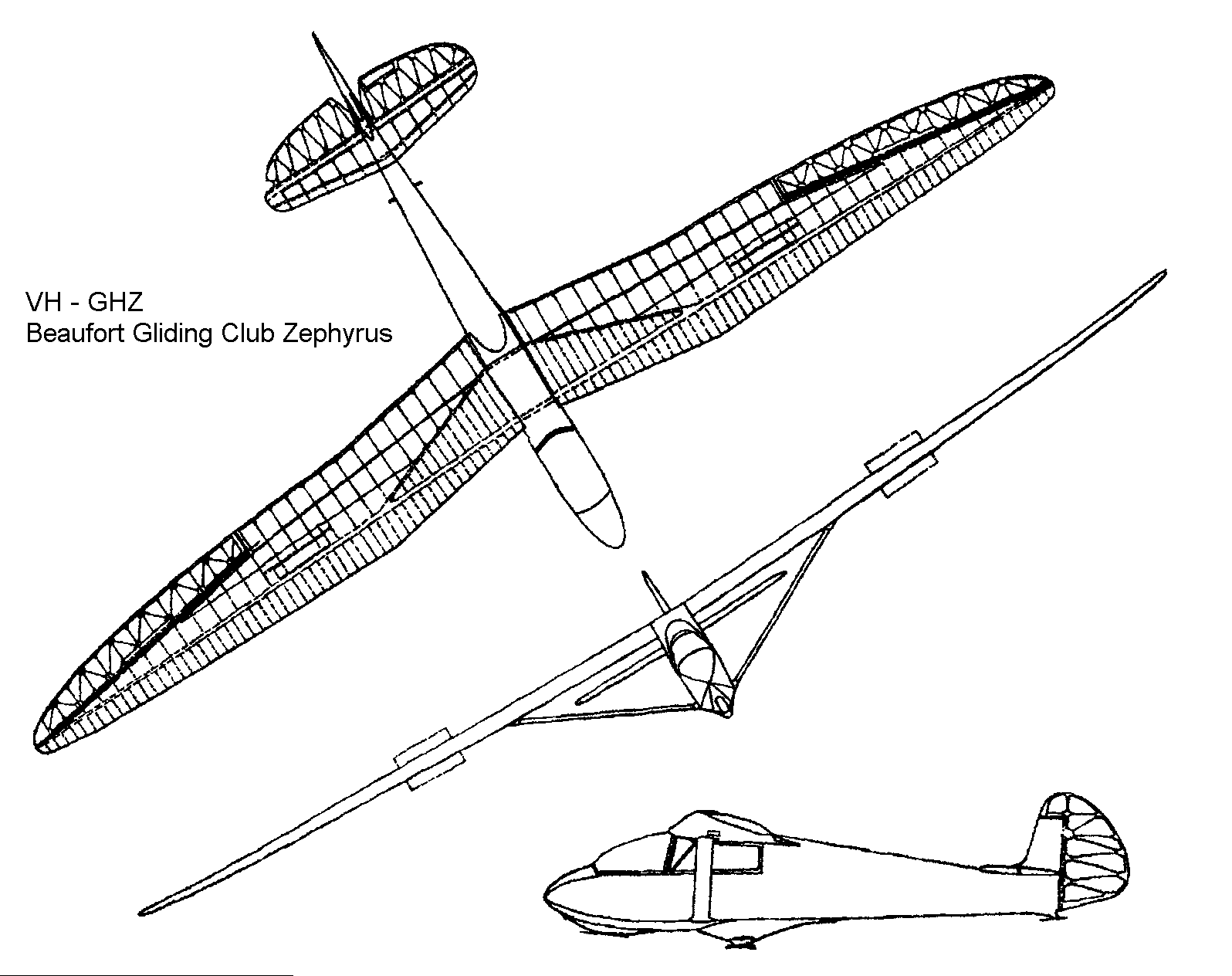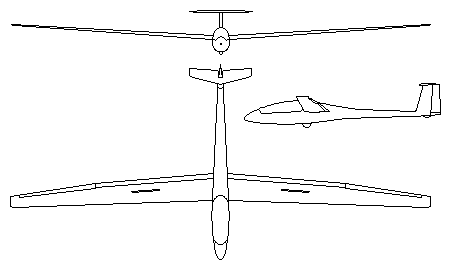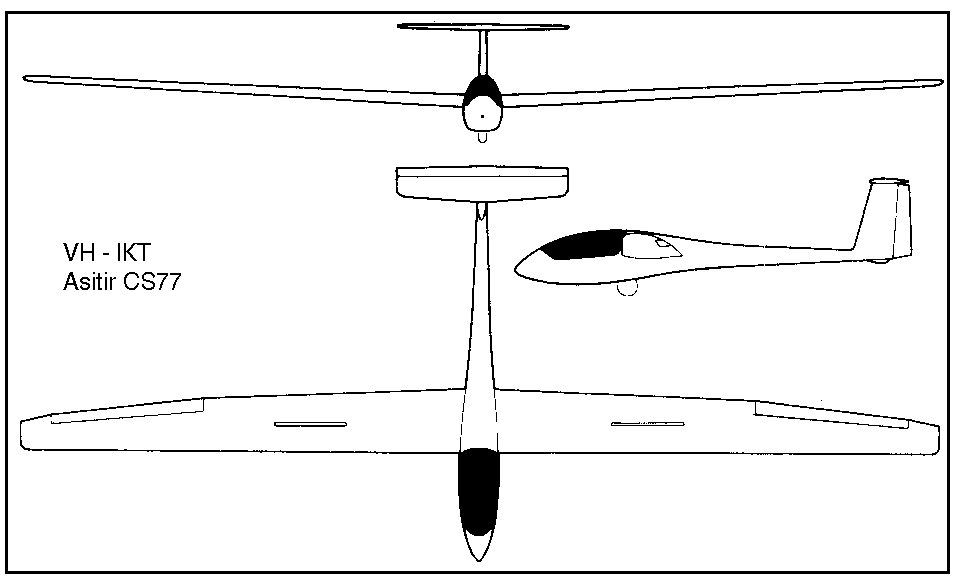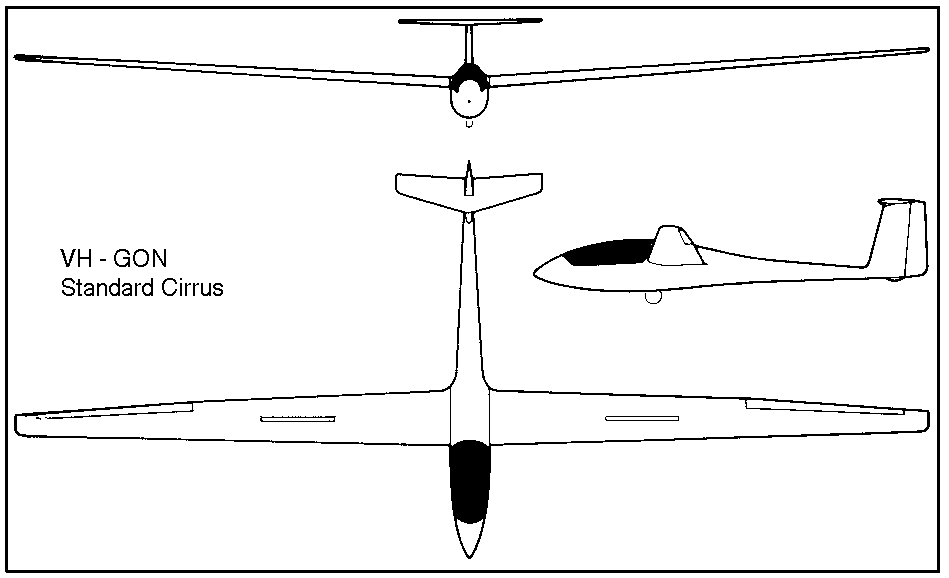Beaufort Gliding Club Zephyrus
VH-GHZ S/N GFA-HB-60
Specifications
- Span:- 17.5m / 56.3ft
- Area:- 21.88m2 / 235.5ft2
- Aspect ratio:- 13.5
- Airfoil:- N.A.C.A. 4415
- Empty weight:- 433kg / 954.6lb
- Payload:- 184kg / 406lb
- Gross weight:- 617kg / 1,360lb
- Wing loading:- 28.17kg/m2 / 5.77lb/ft2
- Structure:- steel tube and wood.
Performance
- L/D:- max. 25 @ 93kph / 50kts
- Vne:- 193kph / 104kts / 120mph
|
 |
| The Beaufort Gliding Club Zephyrus, designed to
American standards, is a two place, high-wing, strutted monoplane.
It was originally designed as a single-seat glider in Melbourne during the late 1940's by
club member Douglas Lyon. The design was modified to a high-performance two-seat configuration in 1951 and construction was commenced by the Beaufort Gliding Club shortly thereafter. Declining membership in the fifties
delayed construction and it was not until 1966 that the glider first flew.
It has a fuselage of steel tube framework covered with fabric. The
wings are of glued wooden construction and have a single main spar. This
spar is continuous and straight between the wing root and the wing tip.
Casein glue has been used throughout the wing and the timbers used have
been spruce for solid sections and birch for plys. A rear false spar
carries the aileron along its outer portion. A drag spar runs between the
rear fuselage attachment fitting and the strut attachment fitting on the
main spar. An unusual feature is that the rear cockpit is accessed through a hinged door on the starboard side. The Zephyrus soars well and has made
many good cross-country flights including several in excess of 300 kms. In 1988 the Zephyrus was placed first on handicap in the Australian National Two-Seat Championships, flying against the more modern Janus and Twin Astir sailplanes. |
|
Top

|
Schempp-Hirth Janus B
VH-IZI S/N 71
Specifications
- Span:- 18.2m / 59.8ft
- Area:- 16.6m2 / 178.7ft2
- Aspect ratio:- 20
- Airfoil:- Wortmann FX-67-K-170/15
- Empty weight:-
370kg / 816lb
- Payload:- 250kg
- Gross weight:- 650kg / 1,367lb
- Wing loading:- 37.4kg/m2 / 7.66lb/ft2
- Structure:- Fibreglass.
Performance
- L/D:- max. 39 @ 95kph / 51kts
- Vne:- 220kph / 119kts
|
 |
| Designed by Klaus Holighaus in 1969, the prototype first
flew in 1974 and production commenced in 1975. The Janus is a high
performance, flapped two-seater fitted with a non-retractable undercarriage
with a Disk brake. The Janus B became available to customers in March
1978, this having a fixed-incidence tailplane instead of the all-moving type
previously fitted. VH-IZI first flew in 1979. |
|
Top

|
Grob G 102 Astir CS-77
VH-IKT S/N 1693
Specifications
- Span:- 15.0m / 49.2ft
- Area:- 12.40m2
/ 133.5ft2
- Aspect ratio:- 18.2
- Airfoil:- Eppler E 603
- Empty weight:- 255kg / 562lb
- Payload:- 195kg / 430lb
- Gross weight:- 450kg / 992lb
- Wing loading:- 36.29kg/m2
/ 7.43lb/ft2
- Structure:- fibreglass
Performance
- L/D:- max. 38 @ 105kph / 56kts / 65mph
- Min sink:- 0.70m/s / 2.3fps / 1.36kts @ 85kph / 46kts
- Vne:- 250kph / 135kts / 155mph
|
 |
| The Astir CS (club standard) was the first
sailplane designed and serially produced by Grob. It features composite (fibreglass/resin)
construction, a large wing Area, a T-tail and Water ballast. A Standard
Class Sailplane, the large wing Area gives good low speed handling
characteristics. The main gear retracts. A slightly improved
version, the CS-77, was introduced in 1977. The CS-77 has a different
rudder profile and a slimmer fuselage than the earlier Astir. |
|
Top

|
Schempp-Hirth Standard Cirrus
75
VH-GON S/N 608
Specifications
- Span:- 15.0m / 49.2ft
- Area:- 10.00m2
/ 107.5ft2
- Aspect ratio:- 22.5
- Airfoil:- Wortmann FX-S-02-196 mod.
- Empty weight:- 220kg / 485lb
- Payload:- 170kg / 375lb
- Water ballast:- 60kg / 132lb
- Gross weight:- 390kg / 860lb
- Wing loading:- 39.0kg/m2
/ 7.99 lb/ft2
- Structure:- steel-tube centre section framework, fibreglass sandwich
fuselage PVC foam core wings with fibreglass skin.
Performance
- L/D:- max 38 @ 90kph / 49kts / 56mph
- Min sink:- 0.57m/s / 1.87fps / 1.01kts @ 75kph / 40kts / 46mph
- Vne:- 220kph / 119kts / 137mph
|
 |
| The Standard Cirrus was a follow-on to the
original Open Class Cirrus design but is a completely different
aircraft. It has a 15m wing with airbrakes on the top surface only,
an all-moving T-tail and is constructed of fibreglass with a steel tube skeleton in the wing-fuselage centre
section. In 1975 an improved version, the Cirrus 75, was
introduced with redesigned wing fairings, larger airbrakes, longer nose,
modified tailplane attachment fitting and other modifications. |
|
Top

|
![]()
![]()